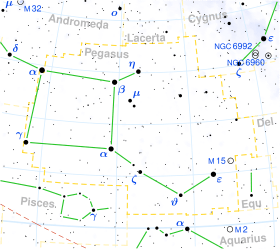2 Pegasi
2 Pegasi is a single[9] star in the constellation Pegasus, located approximately 394 light years away from the Sun based on parallax.[1] It is visible to the naked eye as a faint, red-hued star with an apparent visual magnitude of 4.52.[2] The object is moving closer to the Earth with a heliocentric radial velocity of −19 km/s.[6] It has a magnitude 12.7 visual companion, designated component B, at an angular separation of 30.4″.[10]
| Observation data Epoch J2000 Equinox J2000 | |
|---|---|
| Constellation | Pegasus |
| Right ascension | 21h 29m 56.89545s[1] |
| Declination | 23° 38′ 19.8170″[1] |
| Apparent magnitude (V) | 4.52[2] |
| Characteristics | |
| Evolutionary stage | AGB[3] |
| Spectral type | M1+III[4] |
| U−B color index | +1.93[5] |
| B−V color index | +1.62[5] |
| Astrometry | |
| Radial velocity (Rv) | −18.92[6] km/s |
| Proper motion (μ) | RA: +24.74[1] mas/yr Dec.: +3.63[1] mas/yr |
| Parallax (π) | 8.28 ± 0.18[1] mas |
| Distance | 394 ± 9 ly (121 ± 3 pc) |
| Absolute magnitude (MV) | −0.89[2] |
| Details | |
| Radius | 55[7] R☉ |
| Luminosity | 653[7] L☉ |
| Temperature | 3,919[7] K |
| Other designations | |
| Database references | |
| SIMBAD | data |
This is an aging red giant star with a stellar classification of M1+III,[4] currently on the asymptotic giant branch,[3] having exhausted the hydrogen at its core and evolved away from the main sequence. The interferometry-measured angular diameter of the primary component, after correcting for limb darkening, is 4.52±0.05 mas,[11] which, at its estimated distance, equates to a physical radius of about 59 times the radius of the Sun.[12] It is radiating 653 times the luminosity of the Sun from its enlarged photosphere at an effective temperature of 3,919 K, and the radius calculated from these values is 55 R☉.[7]
References
- Van Leeuwen, F. (2007). "Validation of the new Hipparcos reduction". Astronomy and Astrophysics. 474 (2): 653. arXiv:0708.1752. Bibcode:2007A&A...474..653V. doi:10.1051/0004-6361:20078357. Vizier catalog entry
- Anderson, E.; Francis, Ch. (2012). "XHIP: An extended hipparcos compilation". Astronomy Letters. 38 (5): 331. arXiv:1108.4971. Bibcode:2012AstL...38..331A. doi:10.1134/S1063773712050015. Vizier catalog entry
- Eggen, O. J. (1992), "Asymptotic giant branch stars near the sun", The Astronomical Journal, 104: 275, Bibcode:1992AJ....104..275E, doi:10.1086/116239.
- Hoffleit, D.; Warren, W. H. (1995). "VizieR Online Data Catalog: Bright Star Catalogue, 5th Revised Ed. (Hoffleit+, 1991)". VizieR On-line Data Catalog: V/50. Originally Published in: 1964BS....C......0H. 5050. Bibcode:1995yCat.5050....0H.
- Mallama, A. (2014). "Sloan Magnitudes for the Brightest Stars". The Journal of the American Association of Variable Star Observers. 42: 443. Bibcode:2014JAVSO..42..443M.Vizier catalog entry
- Famaey, B.; Pourbaix, D.; Frankowski, A.; Van Eck, S.; Mayor, M.; Udry, S.; Jorissen, A. (2009). "Spectroscopic binaries among Hipparcos M giants". Astronomy and Astrophysics. 498 (2): 627. arXiv:0901.0934. Bibcode:2009A&A...498..627F. doi:10.1051/0004-6361/200810698.
- Brown, A. G. A.; et al. (Gaia collaboration) (August 2018). "Gaia Data Release 2: Summary of the contents and survey properties". Astronomy & Astrophysics. 616. A1. arXiv:1804.09365. Bibcode:2018A&A...616A...1G. doi:10.1051/0004-6361/201833051. Gaia DR2 record for this source at VizieR.
- "2 Peg". SIMBAD. Centre de données astronomiques de Strasbourg. Retrieved 2019-04-07.
- Eggleton, P. P.; Tokovinin, A. A. (September 2008). "A catalogue of multiplicity among bright stellar systems". Monthly Notices of the Royal Astronomical Society. 389 (2): 869–879. arXiv:0806.2878. Bibcode:2008MNRAS.389..869E. doi:10.1111/j.1365-2966.2008.13596.x.
- Mason, Brian D.; Wycoff, Gary L.; Hartkopf, William I.; Douglass, Geoffrey G.; Worley, Charles E. (2001). "The 2001 US Naval Observatory Double Star CD-ROM. I. The Washington Double Star Catalog". The Astronomical Journal. 122 (6): 3466. Bibcode:2001AJ....122.3466M. doi:10.1086/323920. Vizier catalog entry
- Richichi, A.; Percheron, I.; Khristoforova, M. (February 2005), "CHARM2: An updated Catalog of High Angular Resolution Measurements", Astronomy and Astrophysics, 431: 773–777, Bibcode:2005A&A...431..773R, doi:10.1051/0004-6361:20042039
- Lang, Kenneth R. (2006), Astrophysical formulae, Astronomy and astrophysics library, 1 (3rd ed.), Birkhäuser, ISBN 3-540-29692-1. The radius (R*) is given by:
